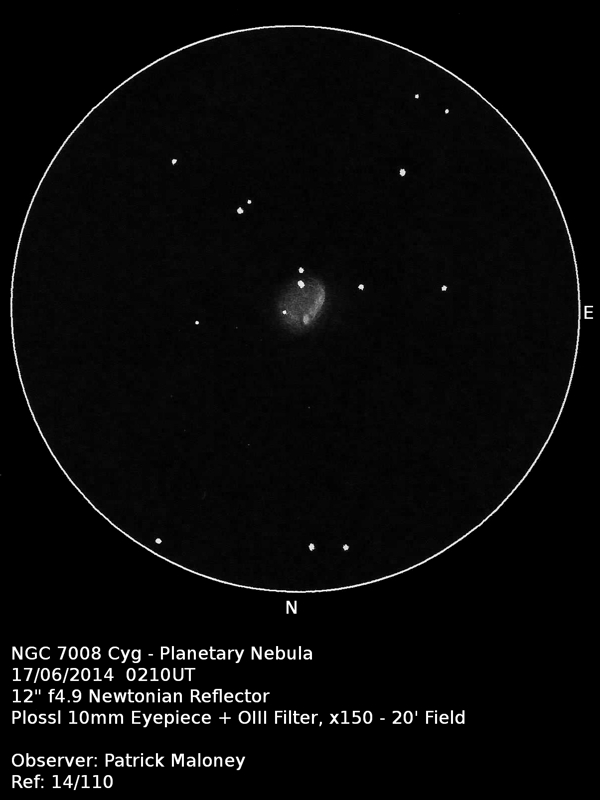NGC 6940 in Vulpecula and NGC 7008 in Cygnus
August 2021 - Nebula and Cluster of the Month
We celebrate the return of astronomical darkness this month with two objects, very different and yet both quite spectacular in their own way. August brings a wealth of fine open clusters to the fore, and one of the nicest is NGC 6940 in Vulpecula. It lies in the north of the constellation, nestled beneath Cygnus’ outstretched eastern wing. It was discovered by William Heschel on the evening of 17 July 1784. He described it thus: A very rich cluster of pretty small, scattered stars, most of the same size. 20’ diameter.
By ‘the same size’, Herschel of course meant ‘the same brightness’. He placed the cluster as the eighth entry in his class VII ‘Pretty much compressed clusters of large or small stars’.

This is an old open cluster, over one billion years, and contains many highly evolved stars. The brightest member star is the M-type SRC semi-regular variable FG Vulpeculae. It varies from magnitude 8.97 to 9.51 in a period of 86 days.
NGC 6940 is a nice visual treat. On first view, it is seen to be contained within a trapezium of 8th magnitude white stars (all A-type). All these stars are slightly brighter than FG Vul, and none of them is a member of the cluster. If you include FG Vul, the pattern made by these stars looks very much like the main asterism of Cassiopeia (a ‘W’ or ‘M’). Contained more-or-less within this little asterism are the other stars of the cluster, as Herschel noted, mostly of much the same brightness, around 11th magnitude. The south-western star of the trapezium is a double, Σ2698, magnitudes 8.8 and 9.7, separation 4.1”.
Different authorities give different membership numbers for the cluster. The Deep-Sky Field Guide to Uranometria gives 60 members, the Night Sky Observer’s Guide 75 members. Archinal & Hynes, enthusiastic as ever, suggest 170, whilst Wikipedia states that there are ‘hundreds’ of members. I made a rough star count at the eyepiece of about 100 stars visible through a 12” reflector in a 36’ field, though not all of these would have been members, and I doubtless missed some fainter ones.
I noted in my observation that the stars are ‘drawn out in quite straggly strings’. An observation by Steve Coe suggests that these are ‘lovely chains of stars.’ You pays your money and you takes your choice. In any event, this is a lovely cluster and worth a visit if you’re in the area.
Our nebula for this month is the remarkable planetary NGC 7008. It lies in the north of Cygnus, 9.5° NNE of Deneb and was discovered – quelle surprise – by William Herschel. He found it on 14th October 1787, describing it as Considerably bright, irregularly formed, 3’ long 2.5’ broad. Nebulosity.
A fairly functional description, but there is so much more to this object.

Wikipedia states that it lies 2800 light-years distant and has a true diameter of around one light-year. That works out about right for its visible diameter of 83”. It must be borne in mind, though, that planetary nebula distances are notoriously difficult to determine.
At magnitude 10.7, NGC 7008 is bright enough to be seen with quite small instruments, presenting a small, bright disc immediately north of the double star h1606, magnitudes 9.3 and 10.2, separation 18”. The double star is a beautiful blue/yellow pair, though observers more romantically inclined than me have described the yellow star as ‘gold’.

Luginbuhl & Skiff in their Observing Handbook note that in small apertures, the planetary nebula can look like a little cluster of four stars. This hints at the detail visible with larger apertures and higher magnifications. The central star is magnitude 13.7, and is difficult, especially when viewed through an OIII filter, which gives the best view of the nebula.
More easily seen is the ‘blob and curl’. The blob is on the northern edge, and a brighter curl wraps round to the east, surrounding a darker area in which the central star lies. On the western edge of the nebula is a small star, magnitude 14.2, which is actually easier to see than the nominally brighter central one.
Patrick Maloney (DeepSkyBagger@gmail.com)
| Object | RA | Dec | Type | Magnitude |
|---|---|---|---|---|
| NGC 6940 | 20h 34m 33s | +28° 16’ 46” | Open cluster | 6.3 |
| NGC 7008 | 21h 00m 34s | +54° 32’ 36” | Planetary nebula | 10.7 |